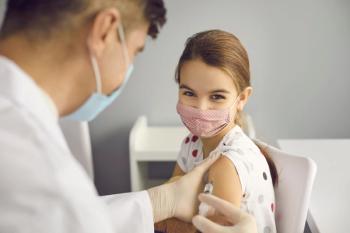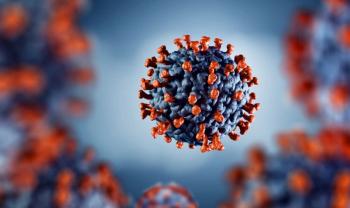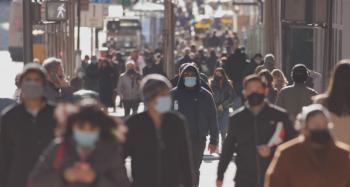
Episode 4: 2 Pandemics, Racism and COVID-19
Episode 4 of Over the Counter tackles dual pandemics: COVID-19 and racism. Experts discuss the most pressing health care and pharmacy issues related to racial disparity and the current COVID-19 pandemic.
Drug Topics®: Welcome to Over the Counter, the podcast from Drug Topics. I'm Gabrielle Ientile.
Drug Topics®: While the COVID-19 pandemic continues to infect the nation with upwards of 3 million cases in the US alone, and thousands of new infections each day, experts are now talking about a second, even deadlier pandemic: racism.
But unlike COVID-19, racism can’t be described as an unprecedented situation. In fact, racial disparities have long been prevalent in health care in the United States, impeding quality patient care, creating worse health outcomes and severely impacting our most basic and fundamental right: that to a long and healthy life.
Here's Dr. Cheryl Wisseh, zone 5 director of the National Pharmaceutical Association (NPhA), to explain the historical factors that continue to divest quality healthcare from black and other minority Americans.
Wisseh: In order to understand structural racism, you need to know that the American society in and of itself has racial discrimination built into the foundation. It's in all of the social structures and systems: housing, education, employment, wage, earnings, credit approval, entertainment, media, and most importantly, health care.
Over time, you have this discrimination that is compounded within these systems and leads to that reinforcement of discriminatory beliefs, and then inequitable distribution of the resources that are within the system.
In thinking of all of that, as we're seeking justice, we need to address these forces of structural racism because it places one group, which is white Americans, at an unfair advantage, and then Black Americans and other like non-black People of Color at disadvantage. There's implicit bias. So thinking about how physicians view patients in their studies that show that physicians would favor their white patients over their black patients, and maybe even think that black patients have less compliant behavior than white patients. So it's set in there within healthcare in and of itself.
Drug Topics®: Many studies have shown that minorities receive less than ideal or standard medical therapies, partly due to 2 related concepts: the culture of medicine and the medical case.
Both of these concepts, which medical students learn and internalize through formal training and through interactions with their peers, prioritize efficiency and progress on a patient's ailment, where distractions from the streamline goal such as socially complex problems, may be seen as derailing to some physicians. Minorities may be seen as being difficult to manage due to stereotyping, but also due to issues informed by the social determinants of health and other existing disparities that overwhelmingly affect minorities in the United States.
Wisseh: In general, those systemic and structural factors are the social determinants of health (SDOH). These are the conditions, those environments, that populations of people are born, live, work, play, worship, and age in. And this is the definition, of course, by healthy people 2020 given by that framework.
In a nutshell, there are tangible and also intangible resources that can affect the quality of life and health outcomes. Depending on which side you fall on those tracks, of whether it's privilege or it's disenfranchisement and lack, they can be life-damaging, but they can also be life-enhancing.
In regards to thinking about that systems approach, the social determinants in and of themselves include your economic stability, your education, the social context, the community context in which you live in, health and healthcare as we've been discussing, the neighborhood and just that overall built environment, and to tie it back to structural racism, is shaped - the social determinants in and of themselves, what we see in people's lives, those conditions - are shaped by how money is distributed, how power is distributed, resources throughout the communities and within the world.
So, the social determinants are somewhat of like a playing field, if you will, and on the social determinants, this foundation, health disparities are built on this. So health disparities are those inequities are in and of themselves built by the structural inequity that comes from structural racism and other structural biases. These domains include race, and then it could be ethnicity, it could be gender or gender identity or class or sexual orientation, but it always is this systemic disadvantage between one social group when compared to the other social groups with whom they coexist. So you juxtapose power and privilege with lack and disenfranchisement.
Drug Topics®: Now the pandemic of racism is working to double-down on these inequities during the COVID-19 pandemic, where Black, Hispanic, Latinx and other non-white minorities are being infected, hospitalized and killed by the virus at much higher rates than whites.
English: I’m an assistant professor at the Rutgers School of Public Health. My training is in clinical community psychology. And as you mentioned, my research focuses on how forms of oppression lead to some of the health inequities that we see across race and sexual orientation such as those in major depression and HIV.
Drug Topics®: That's Dr. Devin English from the Rutgers School of Public Health. Dr. English explained that the high COVID-19 case numbers in minority populations were completely predictable, precisely due to racial disparity factors and racial segregation are already present in healthcare in American life.
English: To understand the inequities in COVID-19 that we're seeing, we must understand the history of the United States. In the example of racial inequities that we're seeing in COVID-19, we must see how the US has become extremely racially and economically segregated. Because what we're seeing with COVID-19 is completely predictable.
Policies like redlining and systematic disinvestment have led to racial segregation that we see in Black and Latinx communities today. Now, this matters because we know that your zip code often determines whether you have high levels of pollution and overcrowding and whether you have access to quality health care and economic opportunity.
Now, right now, Black and Latinx communities, where there are additional disproportionately high levels of pollution and overcrowding and low levels of access to healthcare and economic opportunity, there are also high levels of COVID-19 related risk factors. These include conditions like asthma, the inability to socially isolate or socially distance because there are lots of low-paying yet essential jobs. And there's low lower quality health care in overcrowded and under-resourced local hospitals. Because of this, we are seeing that black and Latinx communities make up huge percentages of COVID-19 related deaths.
Drug Topics®: Here's Dr. Wisseh to expand on some of these issues, including disproportionate COVID-19 cases, hospitalizations and deaths in minority populations through factors such as the presence of comorbid conditions, access to green space, pervasiveness of pollution in black communities, mass incarceration, and homelessness.
Wisseh: COVID-19 has had major impacts on minority health and well-being.
First would be hospitalization. As of June 2020, the confirmed hospitalizations from COVID-19 that are reported, 33% of them were African American, and 22% were Hispanic and Latino. But Hispanic and Latinos are minorities and make up only a fraction of the entire United States population. And then in regards to deaths, while Blacks themselves make up 13% of this overall US population, they account for 24% of COVID-19 deaths that at least we know the race of the person who died. So definitely a disproportionate number of deaths in regards to cases.
Blacks, Latinos, American Indians and Asians account for a disproportionate number of cases in the United States. And to think about it in regards to how the United States sees health, these are minority health disparity population. You see a lot of disparities in these populations anyway, so in regards to how they fare with within each other, non-Hispanic American Indians or Alaskan Natives have a rate that's 5 times more than non-Hispanic white persons in regards to cases and exposure. Non-Hispanic Blacks also have a rate that's approximately 5 times that of non-Hispanic whites. And then Hispanics, their rate is about 4 times that of non-Hispanic whites.
Recently in the news, in the literature, there's data that suggests that because Asian American data is kind of aggregated together, there's fear that we don't necessarily know how those numbers are being reported in Asian Americans. And just going back, this circles back to SDOHs, because this affects health and well-being. Because they can have these ameliorating and damaging effects on health and wellness outcomes, we can talk about this inequitable distribution of social determinants of health being the why we're seeing what we're seeing in COVID-19.
So, a couple of points that I want to make, is that minority populations first of all carry a higher burden of chronic illnesses such as hypertension, which is the number one underlying medical condition of COVID-19 hospitalizations. And other underlying conditions include, just overall, cardiovascular disease, metabolic disease include diabetes, respiratory disease, asthma and COPD.
Minority populations are also likely to live in racially segregated areas. They lack greenspace, have increased exposure to environmental pollution, crime and more food deserts and swamps. They lack access to health care providers, and I even more so, I argue that they lack access to also culturally competent and culturally humble care. And I guess anyone can argue with me about that, but I think that that's something that's definitely lacking. And I can say that because you've seen that a lot of Black families have come out and shared experience of losing a loved one that was not appropriately either triaged or even tested in the beginning of this pandemic and was at home subsequently to die from COVID-19, because maybe there was an implicit bias on how their symptoms were being viewed.
Minority populations are more likely to be essential workers. So this increases exposure to the virus. Minority men, especially those that are Black and Latino, are disproportionately represented within the prison population, the male prison population. This is another area where we're seeing cases being high. And in this case, race is now compounded with the exposure of living in a close living corridor.
Wisseh: And since minorities are more likely to rent and own, so thinking about housing with those SDOHs, they may not own their own home. They may not have privilege to non-essential roles or working jobs, and may have lost their jobs and will be facing homelessness during this pandemic because the moratoriums on evictions and on foreclosures that were set by different states, some have expired this week, and if not renewed, then the proceedings may go forth. And now you have a population who already is predisposed to having disproportionate rates for all of these reasons that I just discussed, but then now, being put out potentially on the street and not having anywhere to live.
So it affects the educational attainment gap as well, because these homes that lack internet access, there are students that live there who may not have had access to their courses, or their classes, and they might look is likely they may not even return to school in the fall.
Then you have to think about multi-generational homes, which, when you think of culture in minority populations, you may have grandma, the parents, and the kids living in the home, and when exposure comes into the home, how do you adequately isolate or quarantine, even in the lack of housing for those who are homeless?
And then one point I'd like to touch on would be the Affordable Care Act (ACA). So we all know that the Affordable Care Act is now on the chopping block. This was legislation that increased the uninsured rates of Hispanics and Blacks across the United States, whether it was because of the adoption or expansion of Medicaid or other programs. I think that if this legislation is overturned, it will be an epic failing of human rights, because I strongly believe, outside of NPhA, talking for myself now, but I strongly believe that equitable health care is a human right. So that's what you're seeing with COVID-19 and how those SDOHs and the inequitable distribution of the social determinants of health are affecting health and wellness outcomes.
Drug Topics®: Dr. Wisseh went through a whirlwind of factors that are informing racism and healthcare and consequently the impacts of COVID-19 on Black and non-black minority Americans. So let's briefly revisit a couple of these factors.
For example, she mentioned the Affordable Care Act and how the legislation significantly improved rates of insured minorities, especially those of Latinx and Black Americans. And while the Affordable Care Act may be overturned in the near future, there already has been an infringement to the Affordable Care Act that disproportionately impacts the health of minorities, particularly minority women.
On July 8, the Supreme Court ruled that employers can refuse their employees birth control coverage on the basis of personal or religious beliefs. This is a problem. According to Supreme Court Justice Ruth Bader Ginsburg, the decision leaves women workers to fend for themselves to seek contraceptive coverage from sources other than their employees’ insurer, and may leave them unable to cover the price of contraception from their own pockets. And as explained by Dr. Wisseh, the decision would disproportionately impact minority women.
Dr. Wisseh also explained the concept of medical mistrust in Black and non-white minority populations, an issue that has been compounded by the COVID-19 pandemic.
Here's Cato Laurencin, an Albert and Wilda Van Dusen Distinguished Professor of Orthopedic Surgery, and director of the Raymond and Beverly Sackler Center for Biomedical, Biological, Physical and Engineering Sciences. Dr. Laurencin presented during Johnson and Johnson's health disparities webinar as part of AIDS 2020 Virtual Conference.
Dr. Laurencin argues that police brutality is another SDOH that informs and bolsters medical mistrust by minorities.
Laurencin: I believe that racism and COVID-19 represent a pandemic on a pandemic in blacks. And the pandemics find themselves synergized to the detriment of blacks and their health. It's discussed medical mistrust in minority communities, racism and unconscious bias in the medical community, and also the lack of access to care.
As examples of how race and racism play a role in medical care: George Floyd, a Black, 46-year-old male who was unarmed and handcuffed by a white Minneapolis police officer, died after the police officer knelt on his neck, making it impossible for him to breathe. Ahmaud Arbery, a 25-year-old black male, was jogging in a neighborhood in Georgia on February 23 2020, when ex-police officer George McMichael, both McMichael and his son Travis, both of whom were white, killed him in a shooting. These are just 2 examples of acts in our country indicative of really the lasting and pervasive prominence and institutionalization of racism.
Law enforcement killings of unarmed Blacks are manifestations of racism and our implicit signals of the lower value placed on Black lives, by legal institutions and by society. Law enforcement targets People of Color for detentions, interrogations and searches without evidence of criminal activity, causing communities to lose trust and law enforcement and hindering community policing efforts.
Negative police interactions associated with worse mental health among Black men in turn cause community members to fear and mistrust other important figures, such as doctors and healthcare institutions. Mistrust of medical authority figures—call this medical distrust—can cause devastating outcomes in times, such as the current COVID-19 pandemic. COVID-19 cases and deaths are on the rise and Blacks. And this we believe to be partially associated with the medical effects of policing, medical mistrust associated with negative police interactions, and medical bias in our healthcare institutions.
Negative police interactions with the public have been well documented through the media, but research on the personal and vicarious have been limited. One study that was done by McFarland demonstrated that negative police interactions, personally as well as vicariously experienced, caused harm and stress, which can be correlated to obesity and increased waist circumference, and is a debilitating burden on Black individuals.
In addition to stress, negative police experiences can cause elevated depression, post-traumatic stress disorder, and anxiety, which in turn can negatively affect the mental health of an individual who is directly or indirectly affected. Studies have demonstrated that Blacks are more likely to experience police brutality than whites, and these experiences correlated negative health effects. In the USA alone, over 200 Black lives are taken each year by police, or at all found that the communities were police killings of unarmed Black Americans have occurred, there is an elevated prevalence depression and PTSD.
Laurencin: Blacks and other minorities are also disproportionately affected by poverty, mass incarceration, infant mortality, limited health care access and health-related conditions including heart disease, diabetes, stroke, kidney disease, respiratory illness and of course, HIV.
Unconscious bias, stereotyping, prejudice, clinical uncertainty that vary depending upon a patient's race and ethnicity on the part of healthcare providers, can lead to these healthcare inequities, creating poor healthcare outcomes in this trust in the health care system. In policing Alang and his colleagues have argued that police brutality is a social determinant of health, which can cause people of different ethnicities to lose trust in USA institutions, such as law—not just in terms of law enforcement, but also medical institutions.
A follow-up study by Alang focused on police brutality and the effects of physical and mental health of Black Americans, and surveyed adults living in urban areas in the US on mistrust, specifically medical mistrust, and perceived police brutality. Police aggression contributes to fatal injuries, poorer physical health symptoms, stress, financial strain, and institutionally oppressive practices that are associated with a spillover effect on the community's trust in medical institutions and positions. The spillover effect can cause devastating health disparities in medical and in the Black community. Medical mistrust was greater among marginalized populations, indicating contemporary racial biases can compound already unequal trade treatment and already unequal access to quality health care. This debilitating burden of police negative interactions has been correlated to medical distrust to the institutionalization of racism, and data by Alang reports that Blacks, Latinos and Native Americans experience higher rates of medical mistrust compared to whites.
Drug Topics®: Laurencin also explained that a contributing factor to medical mistrust is the lack of Black and minority representation in the healthcare system. And Dr. Wisseh agrees.
Wisseh: In regards to that ideological factors of racism and health care, once again, it goes back to the ideology of white supremacy and discrimination that's built within the foundation of the United States and in every system that we see in regards to the social determinants of health.
Within healthcare, when you see this ideology, it can be in what is known as provider concordance. So when you have, let's say, an African American patient and then an African American provider that racial concordance, so generally African American patients with African American physicians are more likely than African American patients with non-minority providers to rate their physicians as excellent and providing health care, treating them with respect, explaining their medical problems, listening to their concerns, being accessible. And this was found in the Institute of Medicine’s report on unequal treatment.
They also found that Hispanic patients with Hispanic positions also were more likely to be satisfied with their overall health care due to that ethnicity. In the state of California, there was a study that looked at physician practices in regards to patient caseload by race and ethnicity. And it showed that half of African American providers and Hispanic providers’ patientload were African American and Hispanic respectively.
And that's good, right? However, African American and Hispanic physicians make up only 6% of the total physician workforce. So that presents a problem. So when you think about education, the system of education now, which also has this structural racism within it, all the way from pre-kindergarten all the way to what would be the completion of less a medical school or other health care, professional, school and training, there are many like very racial and ethnic and socio-economic barriers that would impede someone who is a minority, or who could be a minority position or healthcare provider, from getting to that point.
So, this in turn will contribute to lower numbers of minority physicians. If you have less provider concordance just because you have a lack of minority health care providers, patients might not be receiving that optimal care and health care they deserve. Because once again, they're reporting that that concordance is very important to them.
Drug Topics®: So how does all of this fit into the pharmacy? The first critical step of addressing racial disparities in health care is acknowledgement. It is vital for healthcare professionals to name racism where they work, and to advocate for Black Lives Matter. Refusing to name the issue is one of the key ways that racism is allowed to continue in American society and all of its institutions.
English: We know that one of the most profound forms of oppression is erasure. It is saying that an experience is not happening that is actually there.
Drug Topics®: Dr. Wisseh stresses that racial disparities are already a pharmacist’s issue. And as frontline health care workers who often provide care to some of the most vulnerable communities, it's a non-negotiable one.
Wisseh: One of the tenets in our code of ethics is that a pharmacist serves individual, community and societal needs. So pharmacy and public health do have an intersection in their shared goals to promote the health of individuals, communities and society overall. Racism in all its forms—structural, institutional, interpersonal or even internalized—is a public health issue. So since it has negative impacts on the health of individuals and communities of color and society overall, then that means it becomes a pharmacy issue, because pharmacy has that shared goal with public health.
As pharmacists, if we’re seeking justice, like that tenet says, in the distribution of healthcare resources, since structural racism also affects the healthcare system, we need to address these forces of structural racism, because it places one group, white Americans, at an unfair advantage, and then Black Americans and other like non-black People of Color at disadvantage.
So, for instance, you have the example where the medication availability and pharmacy deserts. You have the literature in pharmacies showing that there's limited access to community pharmacies, the actual establishment, services and commonly used medications based on racial segregation. In recognizing that there's this unearned privilege that in this system, pharmacists must empathize with the plight of Black Americans and strive to truly understand what it means when it is said that all Black lives matter, because for centuries, there have been human suffering on the part of Black Americans in the United States.
That also leads to another part of our oath that we take as pharmacists, that I will consider—the welfare of humanity and relief of suffering—my primary concerns. So it kind of is built into our code of ethics and our oath and we should aim and must live up to that oath, when we take it, because we do take it.
Drug Topics®: That's all for this episode of Over the Counter.
The issue of racial disparity and healthcare is enormously complex and one podcast couldn't possibly cover it all. So if you're interested in learning more about this issue, head over to
And if you enjoyed this podcast, take a second to like, write a review, and share with your pharmacy friends. Thanks for listening.
Newsletter
Pharmacy practice is always changing. Stay ahead of the curve with the Drug Topics newsletter and get the latest drug information, industry trends, and patient care tips.




























































































































